Antioxidative activity of tea polyphenol extracts in soybean oil
Tea polyphenol extracts (TPE) (94.08% dry mater (DM) total polyphenols, 71.14% DM total catechins) at three
concentrations (100 ppm, 200 ppm, and 400 ppm) were examined in soybean oil in accelerated oxidation conditions
at 600C. A sample without antioxidants and a sample with 100 ppm butylated hydroxyanisole (BHA) + 100 ppm
butylated hydroxytoluene (BHT) were used as the negative and positive controls, respectively. The results showed
that TPE was more effective than BHA+BHT for the stability of soybean oil at the same concentration (200 ppm). TPE
was capable of the maintenance of the sensorial properties, and reductions of diene and peroxide formations as well
as the secondary oxidative compounds (p-anisidine). Concerning the TPE concentration, 200 ppm of TPE was
suitable to stabilize the soybean oil quality during storage.
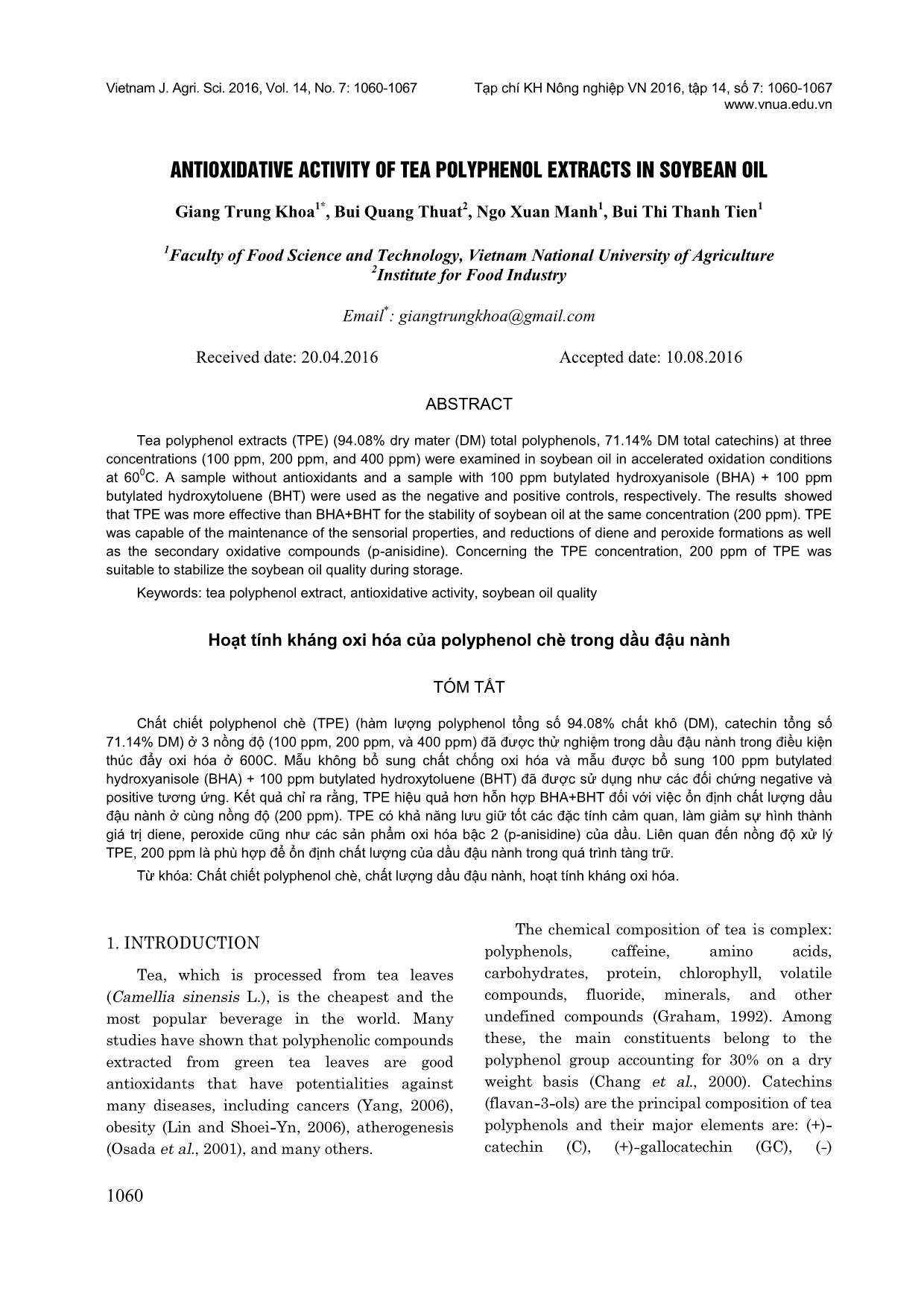
Trang 1
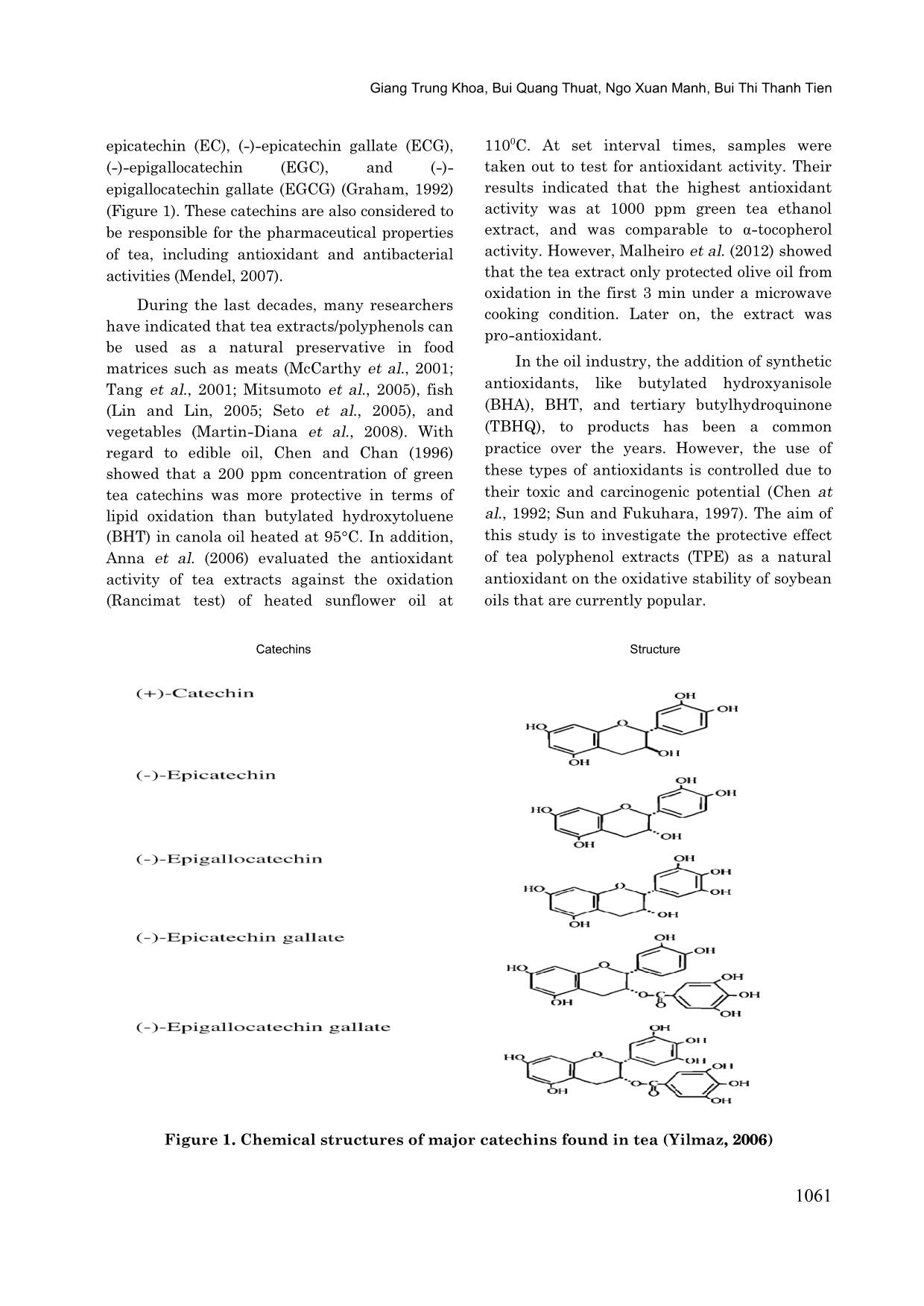
Trang 2
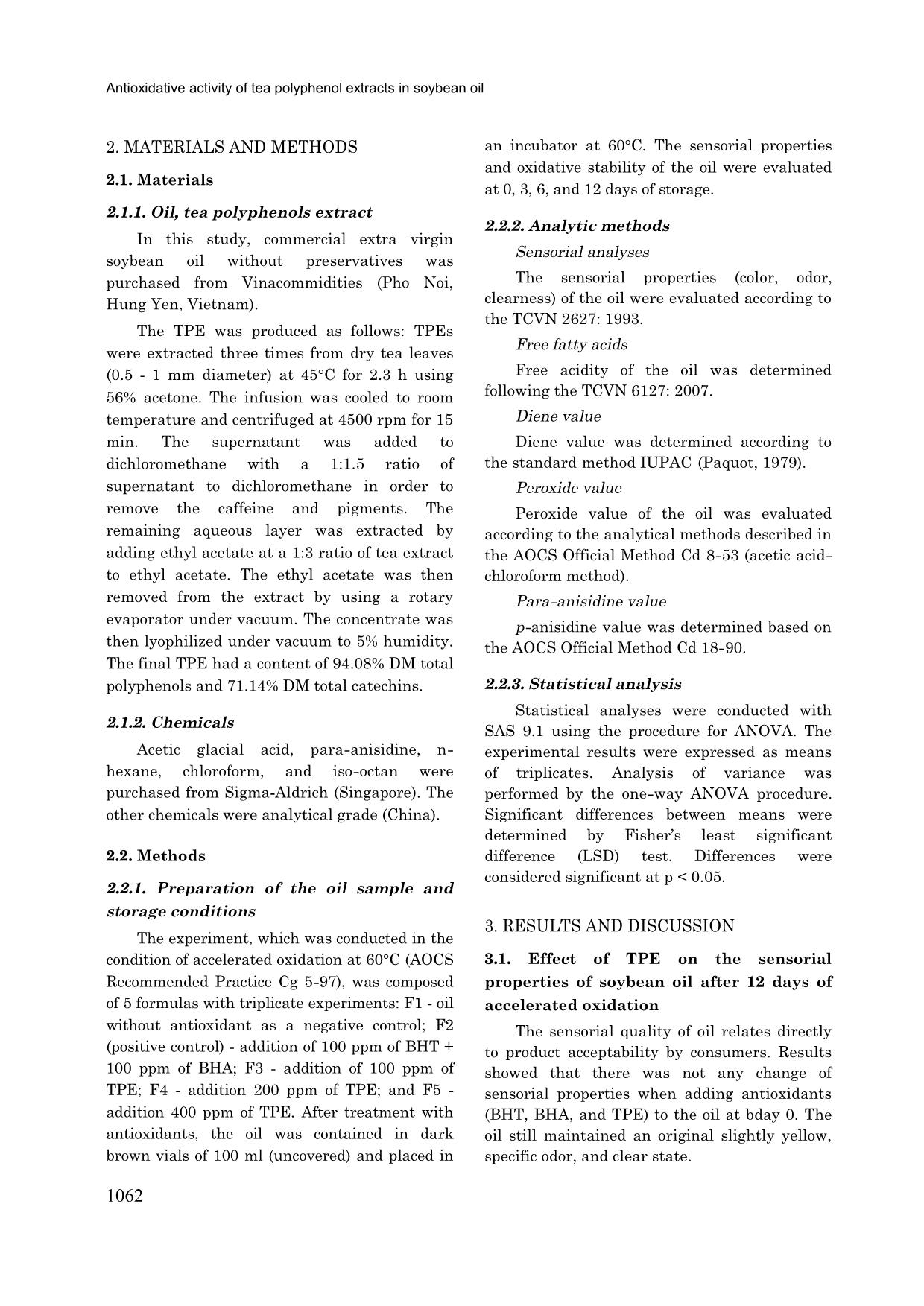
Trang 3
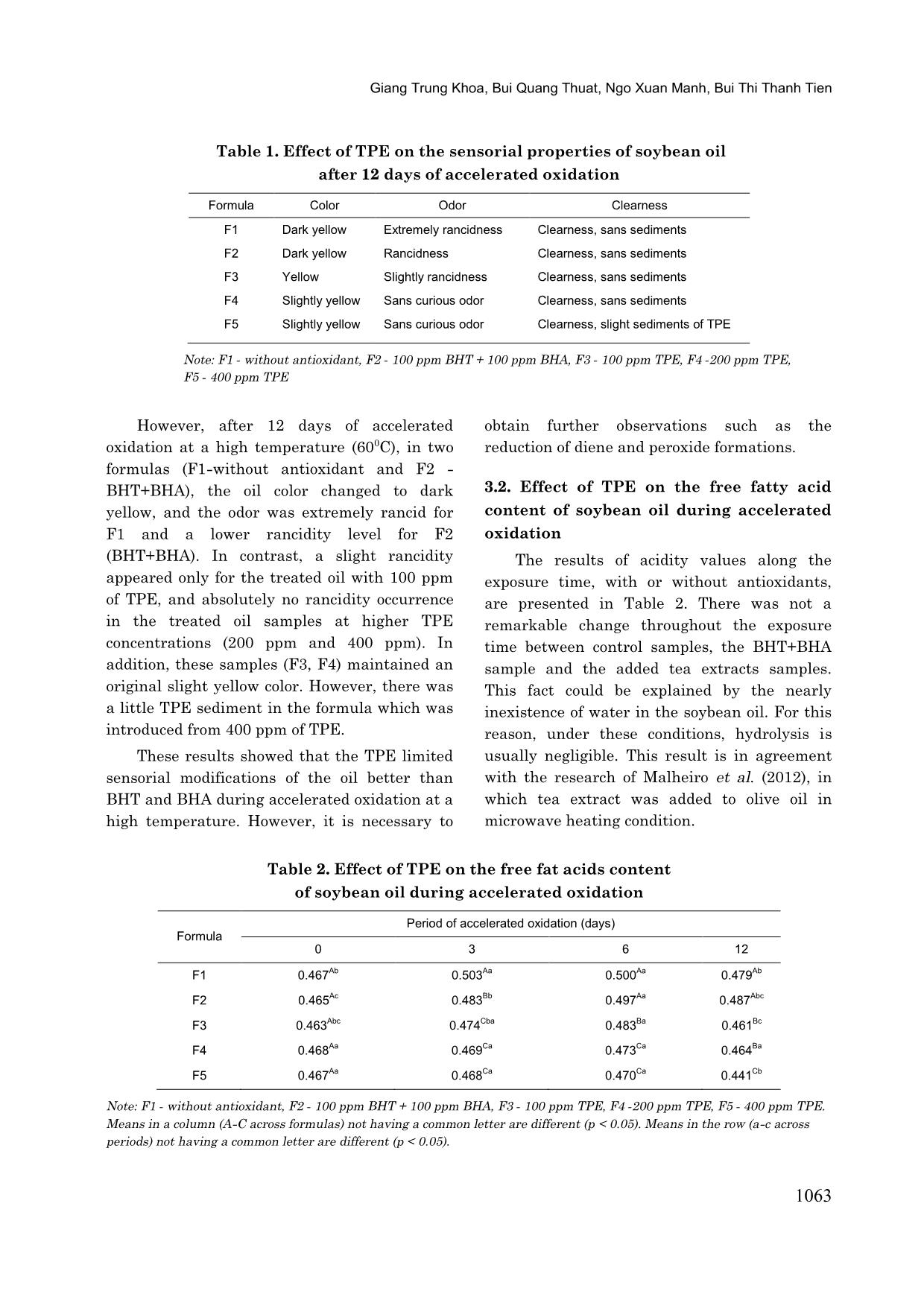
Trang 4
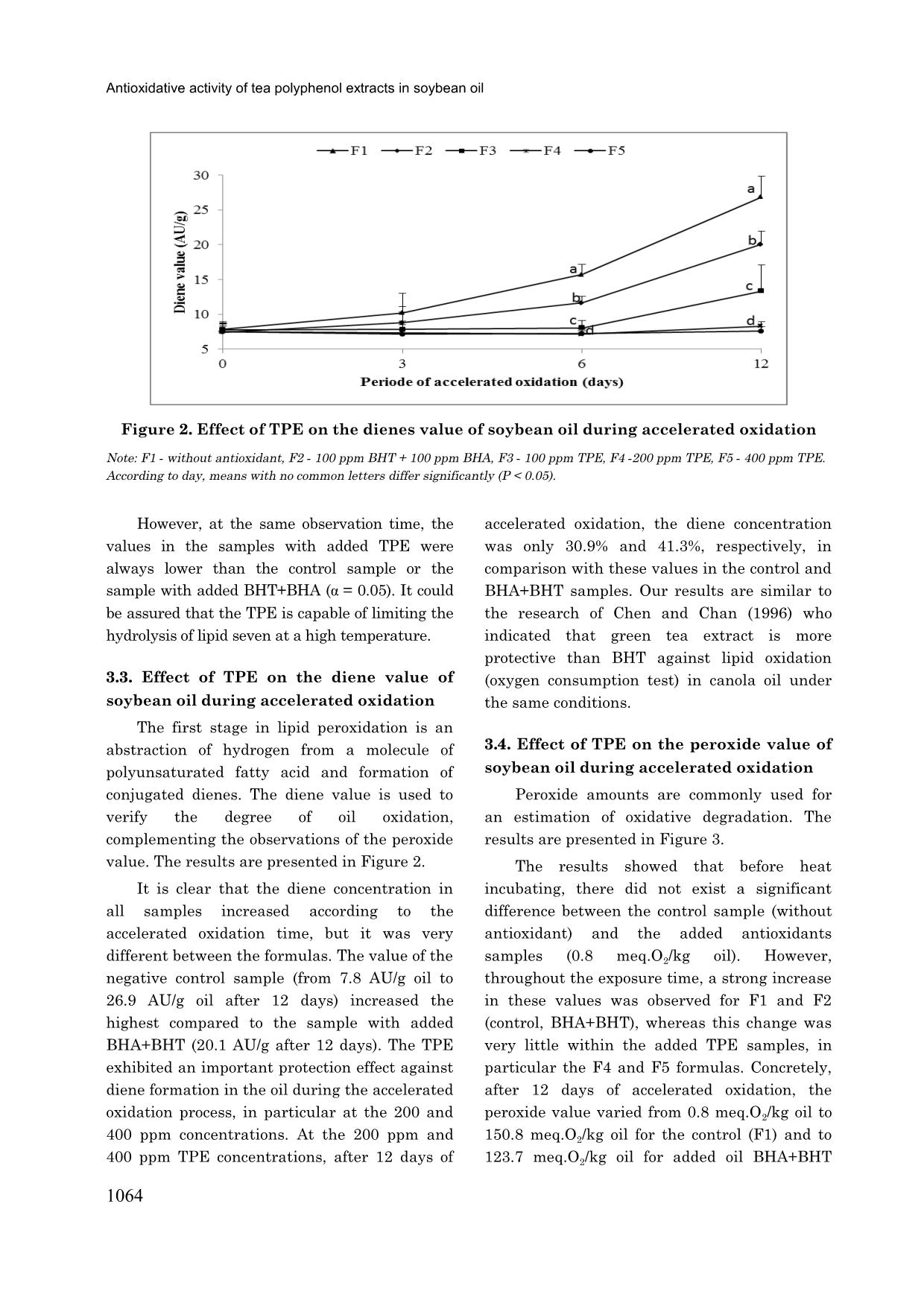
Trang 5
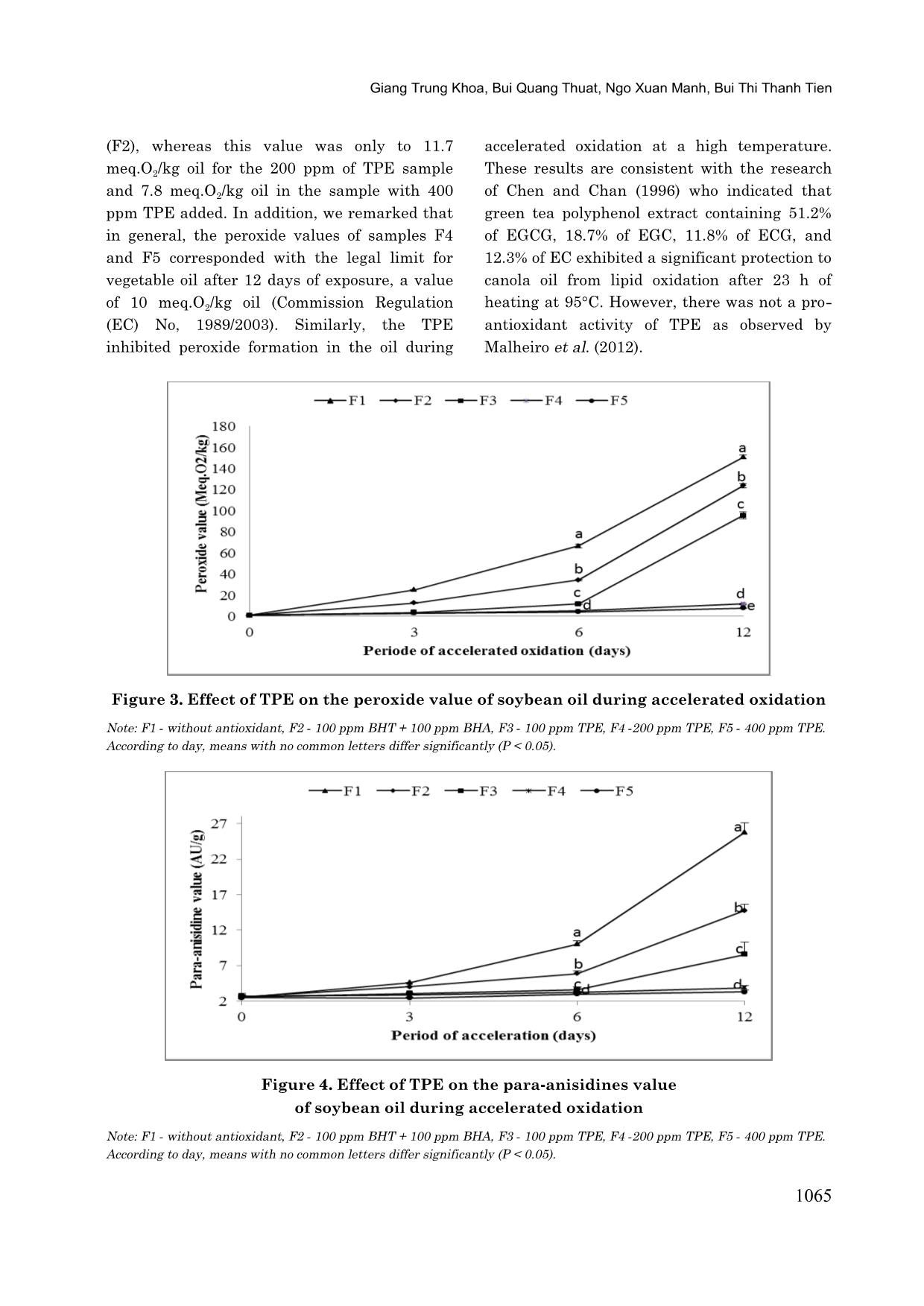
Trang 6
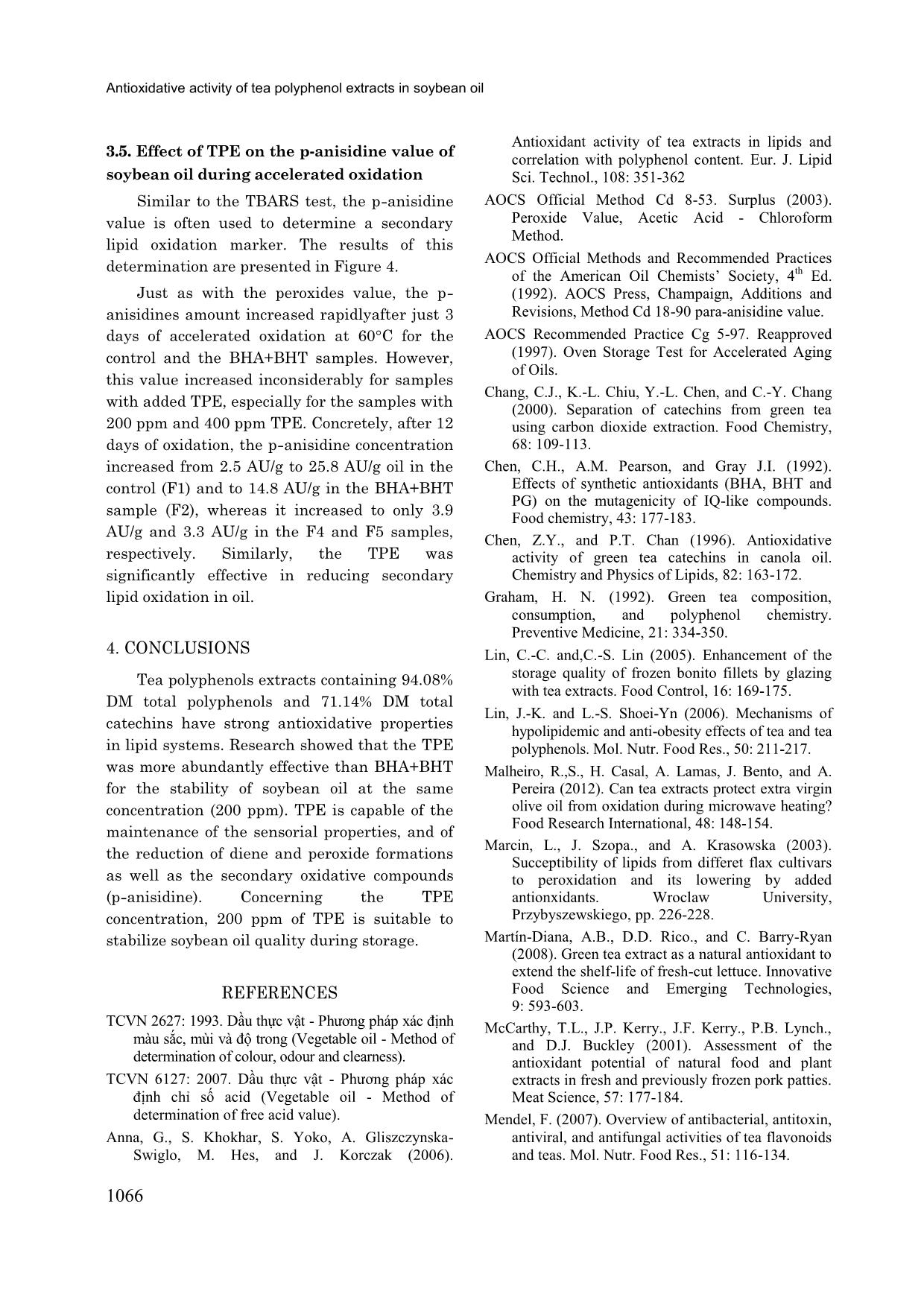
Trang 7

Trang 8
Tóm tắt nội dung tài liệu: Antioxidative activity of tea polyphenol extracts in soybean oil
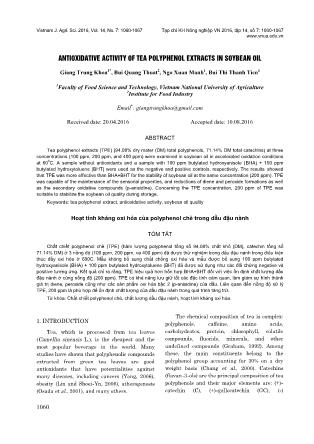
Vietnam J. Agri. Sci. 2016, Vol. 14, No. 7: 1060-1067 Tạp chí KH Nông nghiệp VN 2016, tập 14, số 7: 1060-1067 www.vnua.edu.vn 1060 ANTIOXIDATIVE ACTIVITY OF TEA POLYPHENOL EXTRACTS IN SOYBEAN OIL Giang Trung Khoa 1* , Bui Quang Thuat 2 , Ngo Xuan Manh 1 , Bui Thi Thanh Tien 1 1 Faculty of Food Science and Technology, Vietnam National University of Agriculture 2 Institute for Food Industry Email * : giangtrungkhoa@gmail.com Received date: 20.04.2016 Accepted date: 10.08.2016 ABSTRACT Tea polyphenol extracts (TPE) (94.08% dry mater (DM) total polyphenols, 71.14% DM total catechins) at three concentrations (100 ppm, 200 ppm, and 400 ppm) were examined in soybean oil in accelerated oxidation conditions at 60 0 C. A sample without antioxidants and a sample with 100 ppm butylated hydroxyanisole (BHA) + 100 ppm butylated hydroxytoluene (BHT) were used as the negative and positive controls, respectively. The results showed that TPE was more effective than BHA+BHT for the stability of soybean oil at the same concentration (200 ppm). TPE was capable of the maintenance of the sensorial properties, and reductions of diene and peroxide formations as well as the secondary oxidative compounds (p-anisidine). Concerning the TPE concentration, 200 ppm of TPE was suitable to stabilize the soybean oil quality during storage. Keywords: tea polyphenol extract, antioxidative activity, soybean oil quality Hoạt tính kháng oxi hóa của polyphenol chè trong dầu đậu nành TÓM TẮT Chất chiết polyphenol chè (TPE) (hàm lượng polyphenol tổng số 94.08% chất khô (DM), catechin tổng số 71.14% DM) ở 3 nồng độ (100 ppm, 200 ppm, và 400 ppm) đã được thử nghiệm trong dầu đậu nành trong điều kiện thúc đẩy oxi hóa ở 600C. Mẫu không bổ sung chất chống oxi hóa và mẫu được bổ sung 100 ppm butylated hydroxyanisole (BHA) + 100 ppm butylated hydroxytoluene (BHT) đã được sử dụng như các đối chứng negative và positive tương ứng. Kết quả chỉ ra rằng, TPE hiệu quả hơn hỗn hợp BHA+BHT đối với việc ổn định chất lượng dầu đậu nành ở cùng nồng độ (200 ppm). TPE có khả năng lưu giữ tốt các đặc tính cảm quan, làm giảm sự hình thành giá trị diene, peroxide cũng như các sản phẩm oxi hóa bậc 2 (p-anisidine) của dầu. Liên quan đến nồng độ xử lý TPE, 200 ppm là phù hợp để ổn định chất lượng của dầu đậu nành trong quá trình tàng trữ. Từ khóa: Chất chiết polyphenol chè, chất lượng dầu đậu nành, hoạt tính kháng oxi hóa. 1. INTRODUCTION Tea, which is processed from tea leaves (Camellia sinensis L.), is the cheapest and the most popular beverage in the world. Many studies have shown that polyphenolic compounds extracted from green tea leaves are good antioxidants that have potentialities against many diseases, including cancers (Yang, 2006), obesity (Lin and Shoei-Yn, 2006), atherogenesis (Osada et al., 2001), and many others. The chemical composition of tea is complex: polyphenols, caffeine, amino acids, carbohydrates, protein, chlorophyll, volatile compounds, fluoride, minerals, and other undefined compounds (Graham, 1992). Among these, the main constituents belong to the polyphenol group accounting for 30% on a dry weight basis (Chang et al., 2000). Catechins (flavan-3-ols) are the principal composition of tea polyphenols and their major elements are: (+)- catechin (C), (+)-gallocatechin (GC), (-) Giang Trung Khoa, Bui Quang Thuat, Ngo Xuan Manh, Bui Thi Thanh Tien 1061 epicatechin (EC), (-)-epicatechin gallate (ECG), (-)-epigallocatechin (EGC), and (-)- epigallocatechin gallate (EGCG) (Graham, 1992) (Figure 1). These catechins are also considered to be responsible for the pharmaceutical properties of tea, including antioxidant and antibacterial activities (Mendel, 2007). During the last decades, many researchers have indicated that tea extracts/polyphenols can be used as a natural preservative in food matrices such as meats (McCarthy et al., 2001; Tang et al., 2001; Mitsumoto et al., 2005), fish (Lin and Lin, 2005; Seto et al., 2005), and vegetables (Martin-Diana et al., 2008). With regard to edible oil, Chen and Chan (1996) showed that a 200 ppm concentration of green tea catechins was more protective in terms of lipid oxidation than butylated hydroxytoluene (BHT) in canola oil heated at 95°C. In addition, Anna et al. (2006) evaluated the antioxidant activity of tea extracts against the oxidation (Rancimat test) of heated sunflower oil at 1100C. At set interval times, samples were taken out to test for antioxidant activity. Their results indicated that the highest antioxidant activity was at 1000 ppm green tea ethanol extract, and was comparable to α-tocopherol activity. However, Malheiro et al. (2012) showed that the tea extract only protected olive oil from oxidation in the first 3 min under a microwave cooking condition. Later on, the extract was pro-antioxidant. In the oil industry, the addition of synthetic antioxidants, like butylated hydroxyanisole (BHA), BHT, and tertiary butylhydroquinone (TBHQ), to products has been a common practice over the years. However, the use of these types of antioxidants is controlled due to their toxic and carcinogenic potential (Chen at al., 1992; Sun and Fukuhara, 1997). The aim of this study is to investigate the protective effect of tea polyphenol extracts (TPE) as a natural antioxidant on the oxidative stability of soybean oils that are currently popular. Catechins Structure Figure 1. Chemical structures of major catechins found in tea (Yilmaz, 2006) Antioxidative activity of tea polyphenol extracts in soybean oil 1062 2. MATERIALS AND METHODS 2.1. Materials 2.1.1. Oil, tea polyphenols extract In this study, commercial extra virgin soybean oil without preservatives was purchased from Vinacommidities (Pho Noi, Hung Yen, Vietnam). The TPE was produced as follows: TPEs were extracted thre ... dding antioxidants (BHT, BHA, and TPE) to the oil at bday 0. The oil still maintained an original slightly yellow, specific odor, and clear state. Giang Trung Khoa, Bui Quang Thuat, Ngo Xuan Manh, Bui Thi Thanh Tien 1063 Table 1. Effect of TPE on the sensorial properties of soybean oil after 12 days of accelerated oxidation Formula Color Odor Clearness F1 Dark yellow Extremely rancidness Clearness, sans sediments F2 Dark yellow Rancidness Clearness, sans sediments F3 Yellow Slightly rancidness Clearness, sans sediments F4 Slightly yellow Sans curious odor Clearness, sans sediments F5 Slightly yellow Sans curious odor Clearness, slight sediments of TPE Note: F1 - without antioxidant, F2 - 100 ppm BHT + 100 ppm BHA, F3 - 100 ppm TPE, F4 -200 ppm TPE, F5 - 400 ppm TPE However, after 12 days of accelerated oxidation at a high temperature (600C), in two formulas (F1-without antioxidant and F2 - BHT+BHA), the oil color changed to dark yellow, and the odor was extremely rancid for F1 and a lower rancidity level for F2 (BHT+BHA). In contrast, a slight rancidity appeared only for the treated oil with 100 ppm of TPE, and absolutely no rancidity occurrence in the treated oil samples at higher TPE concentrations (200 ppm and 400 ppm). In addition, these samples (F3, F4) maintained an original slight yellow color. However, there was a little TPE sediment in the formula which was introduced from 400 ppm of TPE. These results showed that the TPE limited sensorial modifications of the oil better than BHT and BHA during accelerated oxidation at a high temperature. However, it is necessary to obtain further observations such as the reduction of diene and peroxide formations. 3.2. Effect of TPE on the free fatty acid content of soybean oil during accelerated oxidation The results of acidity values along the exposure time, with or without antioxidants, are presented in Table 2. There was not a remarkable change throughout the exposure time between control samples, the BHT+BHA sample and the added tea extracts samples. This fact could be explained by the nearly inexistence of water in the soybean oil. For this reason, under these conditions, hydrolysis is usually negligible. This result is in agreement with the research of Malheiro et al. (2012), in which tea extract was added to olive oil in microwave heating condition. Table 2. Effect of TPE on the free fat acids content of soybean oil during accelerated oxidation Formula Period of accelerated oxidation (days) 0 3 6 12 F1 0.467 Ab 0.503 Aa 0.500 Aa 0.479 Ab F2 0.465 Ac 0.483 Bb 0.497 Aa 0.487 Abc F3 0.463 Abc 0.474 Cba 0.483 Ba 0.461 Bc F4 0.468 Aa 0.469 Ca 0.473 Ca 0.464 Ba F5 0.467 Aa 0.468 Ca 0.470 Ca 0.441 Cb Note: F1 - without antioxidant, F2 - 100 ppm BHT + 100 ppm BHA, F3 - 100 ppm TPE, F4 -200 ppm TPE, F5 - 400 ppm TPE. Means in a column (A-C across formulas) not having a common letter are different (p < 0.05). Means in the row (a-c across periods) not having a common letter are different (p < 0.05). Antioxidative activity of tea polyphenol extracts in soybean oil 1064 Figure 2. Effect of TPE on the dienes value of soybean oil during accelerated oxidation Note: F1 - without antioxidant, F2 - 100 ppm BHT + 100 ppm BHA, F3 - 100 ppm TPE, F4 -200 ppm TPE, F5 - 400 ppm TPE. According to day, means with no common letters differ significantly (P < 0.05). However, at the same observation time, the values in the samples with added TPE were always lower than the control sample or the sample with added BHT+BHA (α = 0.05). It could be assured that the TPE is capable of limiting the hydrolysis of lipid seven at a high temperature. 3.3. Effect of TPE on the diene value of soybean oil during accelerated oxidation The first stage in lipid peroxidation is an abstraction of hydrogen from a molecule of polyunsaturated fatty acid and formation of conjugated dienes. The diene value is used to verify the degree of oil oxidation, complementing the observations of the peroxide value. The results are presented in Figure 2. It is clear that the diene concentration in all samples increased according to the accelerated oxidation time, but it was very different between the formulas. The value of the negative control sample (from 7.8 AU/g oil to 26.9 AU/g oil after 12 days) increased the highest compared to the sample with added BHA+BHT (20.1 AU/g after 12 days). The TPE exhibited an important protection effect against diene formation in the oil during the accelerated oxidation process, in particular at the 200 and 400 ppm concentrations. At the 200 ppm and 400 ppm TPE concentrations, after 12 days of accelerated oxidation, the diene concentration was only 30.9% and 41.3%, respectively, in comparison with these values in the control and BHA+BHT samples. Our results are similar to the research of Chen and Chan (1996) who indicated that green tea extract is more protective than BHT against lipid oxidation (oxygen consumption test) in canola oil under the same conditions. 3.4. Effect of TPE on the peroxide value of soybean oil during accelerated oxidation Peroxide amounts are commonly used for an estimation of oxidative degradation. The results are presented in Figure 3. The results showed that before heat incubating, there did not exist a significant difference between the control sample (without antioxidant) and the added antioxidants samples (0.8 meq.O2/kg oil). However, throughout the exposure time, a strong increase in these values was observed for F1 and F2 (control, BHA+BHT), whereas this change was very little within the added TPE samples, in particular the F4 and F5 formulas. Concretely, after 12 days of accelerated oxidation, the peroxide value varied from 0.8 meq.O2/kg oil to 150.8 meq.O2/kg oil for the control (F1) and to 123.7 meq.O2/kg oil for added oil BHA+BHT Giang Trung Khoa, Bui Quang Thuat, Ngo Xuan Manh, Bui Thi Thanh Tien 1065 (F2), whereas this value was only to 11.7 meq.O2/kg oil for the 200 ppm of TPE sample and 7.8 meq.O2/kg oil in the sample with 400 ppm TPE added. In addition, we remarked that in general, the peroxide values of samples F4 and F5 corresponded with the legal limit for vegetable oil after 12 days of exposure, a value of 10 meq.O2/kg oil (Commission Regulation (EC) No, 1989/2003). Similarly, the TPE inhibited peroxide formation in the oil during accelerated oxidation at a high temperature. These results are consistent with the research of Chen and Chan (1996) who indicated that green tea polyphenol extract containing 51.2% of EGCG, 18.7% of EGC, 11.8% of ECG, and 12.3% of EC exhibited a significant protection to canola oil from lipid oxidation after 23 h of heating at 95°C. However, there was not a pro- antioxidant activity of TPE as observed by Malheiro et al. (2012). Figure 3. Effect of TPE on the peroxide value of soybean oil during accelerated oxidation Note: F1 - without antioxidant, F2 - 100 ppm BHT + 100 ppm BHA, F3 - 100 ppm TPE, F4 -200 ppm TPE, F5 - 400 ppm TPE. According to day, means with no common letters differ significantly (P < 0.05). Figure 4. Effect of TPE on the para-anisidines value of soybean oil during accelerated oxidation Note: F1 - without antioxidant, F2 - 100 ppm BHT + 100 ppm BHA, F3 - 100 ppm TPE, F4 -200 ppm TPE, F5 - 400 ppm TPE. According to day, means with no common letters differ significantly (P < 0.05). Antioxidative activity of tea polyphenol extracts in soybean oil 1066 3.5. Effect of TPE on the p-anisidine value of soybean oil during accelerated oxidation Similar to the TBARS test, the p-anisidine value is often used to determine a secondary lipid oxidation marker. The results of this determination are presented in Figure 4. Just as with the peroxides value, the p- anisidines amount increased rapidlyafter just 3 days of accelerated oxidation at 60°C for the control and the BHA+BHT samples. However, this value increased inconsiderably for samples with added TPE, especially for the samples with 200 ppm and 400 ppm TPE. Concretely, after 12 days of oxidation, the p-anisidine concentration increased from 2.5 AU/g to 25.8 AU/g oil in the control (F1) and to 14.8 AU/g in the BHA+BHT sample (F2), whereas it increased to only 3.9 AU/g and 3.3 AU/g in the F4 and F5 samples, respectively. Similarly, the TPE was significantly effective in reducing secondary lipid oxidation in oil. 4. CONCLUSIONS Tea polyphenols extracts containing 94.08% DM total polyphenols and 71.14% DM total catechins have strong antioxidative properties in lipid systems. Research showed that the TPE was more abundantly effective than BHA+BHT for the stability of soybean oil at the same concentration (200 ppm). TPE is capable of the maintenance of the sensorial properties, and of the reduction of diene and peroxide formations as well as the secondary oxidative compounds (p-anisidine). Concerning the TPE concentration, 200 ppm of TPE is suitable to stabilize soybean oil quality during storage. REFERENCES TCVN 2627: 1993. Dầu thực vật - Phương pháp xác định màu sắc, mùi và độ trong (Vegetable oil - Method of determination of colour, odour and clearness). TCVN 6127: 2007. Dầu thực vật - Phương pháp xác định chỉ số acid (Vegetable oil - Method of determination of free acid value). Anna, G., S. Khokhar, S. Yoko, A. Gliszczynska- Swiglo, M. Hes, and J. Korczak (2006). Antioxidant activity of tea extracts in lipids and correlation with polyphenol content. Eur. J. Lipid Sci. Technol., 108: 351-362 AOCS Official Method Cd 8-53. Surplus (2003). Peroxide Value, Acetic Acid - Chloroform Method. AOCS Official Methods and Recommended Practices of the American Oil Chemists’ Society, 4th Ed. (1992). AOCS Press, Champaign, Additions and Revisions, Method Cd 18-90 para-anisidine value. AOCS Recommended Practice Cg 5-97. Reapproved (1997). Oven Storage Test for Accelerated Aging of Oils. Chang, C.J., K.-L. Chiu, Y.-L. Chen, and C.-Y. Chang (2000). Separation of catechins from green tea using carbon dioxide extraction. Food Chemistry, 68: 109-113. Chen, C.H., A.M. Pearson, and Gray J.I. (1992). Effects of synthetic antioxidants (BHA, BHT and PG) on the mutagenicity of IQ-like compounds. Food chemistry, 43: 177-183. Chen, Z.Y., and P.T. Chan (1996). Antioxidative activity of green tea catechins in canola oil. Chemistry and Physics of Lipids, 82: 163-172. Graham, H. N. (1992). Green tea composition, consumption, and polyphenol chemistry. Preventive Medicine, 21: 334-350. Lin, C.-C. and,C.-S. Lin (2005). Enhancement of the storage quality of frozen bonito fillets by glazing with tea extracts. Food Control, 16: 169-175. Lin, J.-K. and L.-S. Shoei-Yn (2006). Mechanisms of hypolipidemic and anti-obesity effects of tea and tea polyphenols. Mol. Nutr. Food Res., 50: 211-217. Malheiro, R.,S., H. Casal, A. Lamas, J. Bento, and A. Pereira (2012). Can tea extracts protect extra virgin olive oil from oxidation during microwave heating? Food Research International, 48: 148-154. Marcin, L., J. Szopa., and A. Krasowska (2003). Succeptibility of lipids from differet flax cultivars to peroxidation and its lowering by added antionxidants. Wroclaw University, Przybyszewskiego, pp. 226-228. Martín-Diana, A.B., D.D. Rico., and C. Barry-Ryan (2008). Green tea extract as a natural antioxidant to extend the shelf-life of fresh-cut lettuce. Innovative Food Science and Emerging Technologies, 9: 593-603. McCarthy, T.L., J.P. Kerry., J.F. Kerry., P.B. Lynch., and D.J. Buckley (2001). Assessment of the antioxidant potential of natural food and plant extracts in fresh and previously frozen pork patties. Meat Science, 57: 177-184. Mendel, F. (2007). Overview of antibacterial, antitoxin, antiviral, and antifungal activities of tea flavonoids and teas. Mol. Nutr. Food Res., 51: 116-134. Giang Trung Khoa, Bui Quang Thuat, Ngo Xuan Manh, Bui Thi Thanh Tien 1067 Mitsumoto, M., M.N. O’Grady., J.P. Kerry., and D.J. Buckley (2005). Addition of tea catechins and vitamin C on sensory evaluation, colour and lipid stability during chilled storage in cooked or raw beef and chicken pattie. Meat Science, 69: 773-779. Osada, K., T. Minako., H. Shinichi., N. Masao., N. Shingo., and S. Michihiro (2001). Tea catechins inhibit cholesterol oxidation accompanying oxidation of low density lipoprotein in vitro. Comparative Biochemistry and Physiology Part C, 128: 153-164. Paquot, C. (1979). Standards Methods for the Analysis of Oils, Fats and Derivatives. Pergamon press, Oxford: 71-75. Seto, Y., C.-C. Lin., Y. Endo., and K. Fujimoto (2005). Retardation of lipid oxidation in blue sprat by hot water tea extracts. Journal of the Science of Food and Agriculture, 85(7): 1119-1124. Sun, B. X., and M. Fukuhara(1997). Effects of co- administration of butylated hydroxytoluene, butylated hydroxyanisole and flavonoids on the activation of mutagens and drug-metabolizing enzymes in mice. Toxicology, 37: 44-48. Tang, S., J.P. Kerry., D. Sheehan., D.J., Buckley., and P.A. Morrissey (2001). Antioxidative effect of added tea catechins on susceptibility of cooked red meat, poultry and fish patties to lipid oxidation. Food Research International, 34: 651-657. Yang, C.S., S. Shengmin., D.L. Joshua., H. Zhe., J. Jihyeung., and L. Gang (2006). Possible mechanisms of the cancer-preventive activities of green tea. Mol. Nutr. Food Res., 50: 170-175. Yilmaz Y. (2006). Novel uses of catechins in foods. Trends in Food Science & Technology, 17: 64-71.
File đính kèm:
 antioxidative_activity_of_tea_polyphenol_extracts_in_soybean.pdf
antioxidative_activity_of_tea_polyphenol_extracts_in_soybean.pdf

